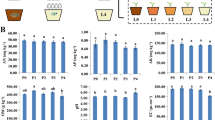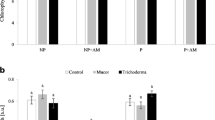Abstract
The use of “alpeorujo” (dry olive residue) has been proposed as an organic amendment in order to enhance soil structure and to increase C storage in soils. The aim of this work is to study how aqueous alpeorujo (ADOR) extracts bioremediated with white-rot fungi and three representative phenolic acids present in this extract (protocatechuic, vanillic and caffeic acid) affect the growth of the arbuscular mychorrhizal fungus Rhizophagus custos in monoxenic culture. Our results show that ADOR decreased mycorrhization parameters; however, this negative effect ceased after ADOR bioremediation. Although protocatechuic and vanillic acids have drastic negative effects at high concentrations, these phenols enhance mycorrhization processes at low concentrations and caffeic acid negatively affects symbiosis at low concentrations. Finally, the capacity of root biomass to dissipate individual phenols was also estimated, in which mycorrhized roots improve phenol dissipation in the growth medium in the presence of different phenols. This study highlights the important role played by arbuscular mycorrhiza in protecting plants from phytotoxicity.


Similar content being viewed by others
References
Agostini E, Talano M, Gonzalez P, Wevar Oller A, Medina M (2010) Phytoremediation of phenolic compounds: recent advances and perspectives. In: Golubev IA (ed) Handbook of phytoremediation. Nova Sciences Publishers, New York, pp 1–50
Alburquerque J, Gonzálvez J, Tortosa G, Baddi G, Cegarra J (2009) Evaluation of “alperujo” composting based on organic matter degradation, humification and compost quality. Biodegradation 20:257–270
Almonacid L, Fuentes A, Ortiz J, Salas C, García-Romera I, Ocampo JA, Arriagada C (2015) Effect of mixing soil saprophytic fungi with organic residues on the response of Solanum lycopersicum to arbuscular mycorrhizal fungi. Soil Use Manage 31:155–164
Aranda E, García-Romera I, Ocampo JA, Carbone V, Mari A, Malorni A, Sannino F, De Martino A, Capasso R (2007) Chemical characterization and effects on Lepidium sativum of the native and bioremediated components of dry olive mill residue. Chemosphere 69:229–239
Aranda E, Sampedro I, Díaz R, García-Sánchez M, Arriagada C, Ocampo JA, García-Romera I (2009) The effects of the arbuscular mycorrhizal fungus Glomus deserticola on growth of tomato plants grown in the presence of olive mill residues modified by treatment with saprophytic fungi. Symbiosis 47:133–140
Aranda E, Sampedro I, Díaz R, García-Sánchez M, Siles JA, Ocampo JA, García-Romera I (2010) Dry matter and root colonization of plants by indigenous arbuscular mycorrhizal fungi with physical fractions of dry olive mill residue inoculated with saprophytic fungi. Span J Agric Res 8(S1):79–85
Aranda E, Sampedro I, Ocampo JA, García-Romera I (2004) Contribution of hydrolytic enzymes produced by saprophytic fungi to the decrease in plant toxicity caused by water-soluble substances in olive mill dry residue. Appl Microbiol Biotechnol 64:132–135
Aranda E, Sampedro I, Ocampo JA, García-Romera I (2006) Phenolic removal of olive mill dry residue by laccase activity of white rot fungi and its impact on tomato plants growth. Int Biodeter Biodegr 58:176–179
Aranda E, Scervino JM, Godoy P, Reina R, Ocampo JA, Wittich RM, García-Romera I (2013) Role of arbuscular mycorrhizal fungus Rhizophagus custos in the dissipation of PAHs under root-organ culture conditions. Environ Pollut 181:182–189
Arriagada C, Aranda E, Sampedro I, García-Romera I, Ocampo JA (2009) Interactions of Trametes versicolor, Coriolopsis rigida and the arbuscular mycorrhizal fungus Glomus deserticola on the copper tolerance of Eucalyptus globulus. Chemosphere 77:273–278
Bago B, Azcón-Aguilar C, Goulet A, Pich Y (1998) Branched absorbing structures (BAS): a feature of the extraradical mycelium of symbiotic arbuscular mycorrhizal fungi. New Phytol 139:375–388
Bécard G, Fortin JA (1988) Early events of vesicular–arbuscular mycorrhiza formation on Ri T-DNA transformed roots. New Phytol 108:211–228
Cayuela M, Sánchez-Monedero M, Roig A (2010) Two-phase olive mill waste composting: enhancement of the composting rate and compost quality by grape stalks addition. Biodegradation 21:465–473
Chabot C, Bécard G, Piché Y (1992) Life cycle of Gomus intraradix in root organ culture. Mycologia 84:315–321
Debiane D, Garcon G, Verdin A, Fontaine J, Durand R, Shirali P, Grandmougin-Ferjani A, Lounes-Hadj SA (2009) Mycorrhization alleviates benzo[a]pyrene-induced oxidative stress in an in vitro chicory root model. Phytochemistry 70:1421–1427
Fries LM, Pacovsky R, Safir G, Siqueira J (1997) Plant growth and arbuscular mycorrhizal fungal colonization affected by exogenously applied phenolic compounds. J Chem Ecol 23:1755–1767
García-Sánchez M, Garrido I, Casimiro IDJ, Casero PJ, Espinosa F, García-Romera I, Aranda E (2012) Defence response of tomato seedlings to oxidative stress induced by phenolic compounds from dry olive mill residue. Chemosphere 89:708–716
García-Sánchez M, Ocampo JA, García-Romera I, Aranda E (2016) Physiological response of mycorrhizal symbiosis to soil pollutants. In: Holly Regan-Jones, (ed) Plant-Environment Interaction: Responses and Approaches to Mitigate Stress, John Wiley Publisher. pp 214–233
García-Sánchez M, Palma JM, Ocampo JA, García-Romera I, Aranda E (2014) Arbuscular mycorrhizal fungi alleviate oxidative stress induced by ADOR and enhance antioxidant responses of tomato plants. J Plant Physiol 171:421–428
Glass ADM (1974) Influence of phenolic acids upon ion uptake. III Inhibition of potassium absorption J Exp Bot 25:1104–1113
Glass ADM (1975) Inhibition of phosphate uptake in barley roots by hydroxy-benzoic acids. Phytochemistry 14:2117–2130
Glass ADM, Dunlop J (1974) Influence of phenolic acids on ion uptake. IV Depolarization of membrane potentials Plant Physiol 54:855–858
Justino CL, Pereira R, Freitas A, Rocha-Santos TP, Panteleitchouk TL, Duarte A (2012) Olive oil mill wastewaters before and after treatment: a critical review from the ecotoxicological point of view. Ecotoxicology 21:615–629
López-Piñeiro A, Albarrán A, Nunes JMR, Barreto C (2008) Short and medium-term effects of two-phase olive mill waste application on olive grove production and soil properties under semiarid mediterranean conditions. Bioresour Technol 99:7982–7987
López-Piñeiro A, Albarrán A, Rato Nunes JM, Peña D, Cabrera D (2011) Long-term impacts of de-oiled two-phase olive mill waste on soil chemical properties, enzyme activities and productivity in an olive grove. Soil Till Res 114:175–182
Martín J, Sampedro I, García-Romera I, García-Garrido JM, Ocampo JA (2002) Arbuscular mycorrhizal colonization and growth of soybean (Glycine max) and lettuce (Lactuca sativa) and phytotoxic effects of olive mill residues. Soil Biol Biochem 34:1769–1775
Medina A, Jakobsen I, Egsgaard H (2011) Sugar beet waste and its component ferulic acid inhibits external mycelium of arbuscular mycorrhizal fungus. Soil Biol Biochem 43:1456–1463
Newman EI (1966) A method of estimating the total length of root in a sample. J Appl Ecol 3:139–145
Parniske M (2008) Arbuscular mycorrhiza: the mother of plant root endosymbioses. Nat Rev Micro 6:763–775
Phillips JM, Hayman DS (1970) Improved procedures for clearing roots and staining parasitic and vesicular-arbuscular mycorrhizal fungi for rapid assessment of infection. Trans Br Mycol Soc 55:158–161
Reina R, Liers C, Ocampo JA, García-Romera I, Aranda E (2013) Solid state fermentation of olive mill residues by wood- and dung-dwelling Agaricomycetes: effects on peroxidase production, biomass development and phenol phytotoxicity. Chemosphere 93:1406–1412
Reina R, Ullrich R, García-Romera I, Liers C, Aranda E (2016) Integrated biovalorization of wine and olive mill by-products to produce enzymes of industrial interest and soil amendments. Span J Agric Res 14(3)
Ribereau-Gayon P (1968) Les Composes Phenoliques des Vegetaux. Dumond, Paris, p 378
Rice EL (1984) Allelopathy. Physiological Ecology. Academic press, New York
Sampedro I, Aranda E, Díaz R, García-Sanchez M, Ocampo JA, García-Romera I (2008) Saprobe fungi decreased the sensitivity to the toxic effect of dry olive mill residue on arbuscular mycorrhizal plants. Chemosphere 70:1383–1389
Sampedro I, Aranda E, Martín J, García-Garrido JM, García-Romera I, Ocampo JA (2004) Saprobic fungi decrease plant toxicity caused by olive mill residues. App Soil Ecol 26:149–156
Scervino JM, Ponce MA, Erra-Bassells R, Vierheilig H, Ocampo JA, Godeas A (2005) Arbuscular mycorrhizal colonization of tomato by Gigaspora and Glomus species in the presence of root flavonoids. J Plant Physiol 162:625–633
Smith SE, Read DJ (2008) Mycorrhizal symbiosis, 3rd edn. Elsevier and Academic Press, New York, London, Burlington, San Diego
Thangarajan R, Bolan NS, Tian G, Naidu R, Kunhikrishnan A (2013) Role of organic amendment application on greenhouse gas emission from soil. Sci Total Environ 465:72–96
Tisserant E, Kohler A, Dozolme-Seddas P, Balestrini R, Benabdellah K, Colard A et al (2012) The transcriptome of the arbuscular mycorrhizal fungus Glomus intraradices (DAOM 197198) reveals functional tradeoffs in an obligate symbiont. New Phytol 193:755–769
Trouvelot A, Kough JL, Gianinazzi-Pearson V (1986) Measure du taux de mycorrhization VA d’un système radiculaire. Recherché de methods d’estimation ayant une signification fonctionelle. In: Gianinazzi-Pearson V, Gianinazzi S (eds) Physiological and genetical aspects of mycorrhizae. INRA, Paris, France, pp 217–221
Wacker TL, Safir GR, Stephens CT (1990) Effects of ferulic acid on Glomus fasciculatum and associated effects on phosphorus uptake and growth of asparagus (Asparagus officinalis L.) J Chem Ecol 16:901–909
Acknowledgements
This study was carried out thanks to financial support from the Ministry of Economy and Competitiveness (MINECO) within the framework of project AGL2012-32873. R. Reina gratefully acknowledges the support provided by the JAE-Pre Program which is co-financed by CSIC and the European Social Fund. E. Aranda thanks the Ministry of Economy and Competitiveness (MINECO) and FEDER funds for co-funding the Ramón y Cajal contract (RYC-2013-12481). LC-MS/MS analyses were carried out by Dr. Lourdes Sánchez-Moreno at the Scientific Instrumentation Service of the Estación Experimental del Zaidín (CSIC), Granada, Spain. Finally, we wish to thank Michael O’Shea for proof-reading the document and Maribel Tamayo Navarrete for technical support.
Author information
Authors and Affiliations
Corresponding author
Additional information
Section Editor: Eckhard Thines
Electronic supplementary material
ESM 1
(DOCX 6362 kb)
Rights and permissions
About this article
Cite this article
Montes, N., Reina, R., Ortiz, T. et al. Interactions between phenolic compounds present in dry olive residues and the arbuscular mycorrhizal symbiosis. Mycol Progress 16, 567–575 (2017). https://doi.org/10.1007/s11557-017-1293-1
Received:
Revised:
Accepted:
Published:
Issue Date:
DOI: https://doi.org/10.1007/s11557-017-1293-1




